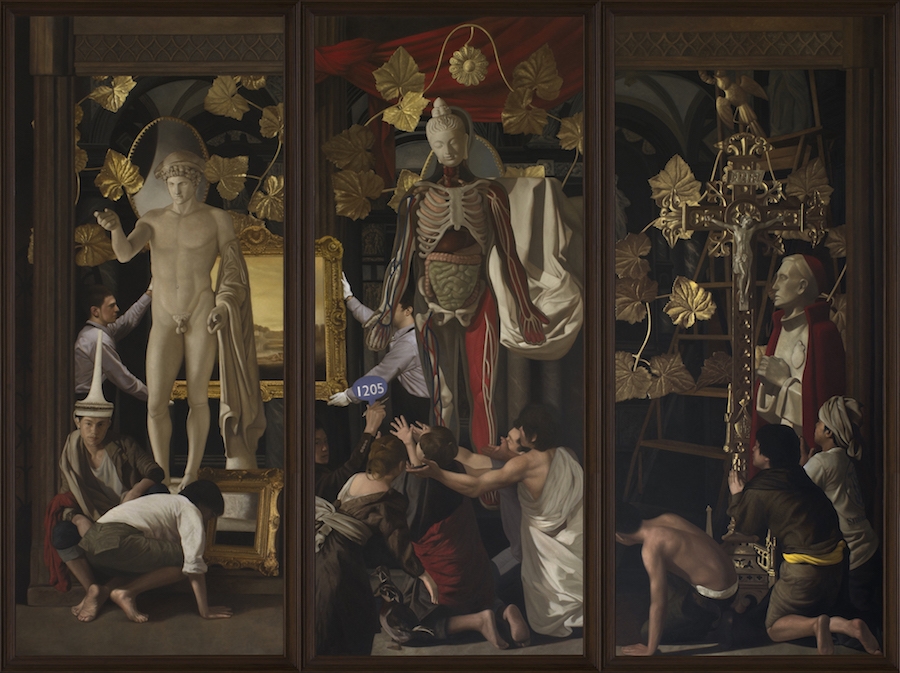Ayala Museum, Manila,18 February – 9 April
Over the course of four years, Thai painter Natee Utarit has painted 12 large ‘altarpieces’: diptychs, triptychs and polyptychs (the latter comprising up to seven separate panels). In their forms, these pieces are inspired by Renaissance Christian altarpieces, but their content is more eclectic, filled with Buddhist imagery and samplings of modern and contemporary art references (among them Warhol’s Brillo Box, 1964), as well as random bits of taxidermy.
It would be boorish not to be impressed by his persistence and commitment to making these highly detailed and considered works. But what exactly do they mean and what is their relationship to Christian altarpieces? Although trained in classical Western painting, Utarit is Thai and a practising Buddhist. Both the imagery in and layout of his altarpieces are very different from any Renaissance painting. While a Renaissance altarpiece would traditionally have at its centre a clear focus for devotion – an image of Christ crucified, the Madonna and child, or a saint – Utarit’s compositions are far more complicated, puzzles rather than icons. There is no simple, reverent viewing: in one painting a Madonna and child do appear, but our view of them is impeded by yellow tapes emblazoned with ‘Police Line Do Not Cross’.) While a Renaissance artist would have shared a coherent iconography with the congregation of the church, Utarit mixes quotes from Beuys or Steinbach with motifs from Old Master paintings and Buddhist imagery. It is unlikely anyone will spot most of these symbols and references. How many would recognise that a red turban on a skeleton in one painting is derived from the Flemish painter Jan van Eyck, or that the ermines (stoats who have white fur in the winter) are emblematic of the peerage, or purity?
It is uncertain what these postmodern incongruities add up to, for the conjunctions are indeed jarring: the naked Eve next to Duchamp’s bicycle wheel; a giraffe’s skeleton next to a naked woman, a badger and a man playing an organ. It all starts to feel as though one were in a storage room where taxidermied animals and skeletons are surrounded by bric-a-brac. Models come in and pose in costumes as though for a fashion show or a charade. A charade that is presumably intended to show the hubris of Western colonialism and materialism. In one painting white men in costumes like those worn by Holbein’s The Ambassadors (1533) survey a map of Southeast Asia, presumably to divide it up into colonies. But the paintings are too complicated, too personal and arcane to sustain any such direct or consistent message. In a lecture he talked of how, as he made the paintings, spiderwebs of references and associations grew. All this may be fun for those collectors who own them to tease out the references and speculate what they mean, but the ordinary gallerygoer is likely to be impressed by the skills without having much sense of what they are about.
For example, in the centre of Nescientia (2014; Latin for ‘unknowing’) is the Buddha – or rather an anatomical model topped with a Buddha head. His pose is that which traditionally depicts the moment of enlightenment. To the left is the Apollo Belvedere, an epitome of classical Greek art and beauty, to the right is an ornate crucifix with a sculpture of a cardinal beside it. Below the Buddha and the crucifix are common people imploring or praying. Are we meant to see the three epitomes as equivalent, or Buddha as the superior? Or is everything undercut anyway by the presence of an auctioneer’s paddle? To the left a Thai man looks back at us, understandably puzzled.
Are they good paintings? Ambitious certainly and impeccably crafted, though the flawless surface makes the figures look strangely motionless and posed. Although Utarit makes much use of photographs and computer modelling, he paints in a very traditional way: first in grisaille, then adding colour. In his lecture he also talked of how as he worked on them his admiration for the original Renaissance painters grew. So the paintings seek to work in a paradoxical way, as simultaneously a critique of Western culture and an homage to Renaissance painters. Also, they want to promote a Buddhist sense of inner calmness. In one painting (The Silent Gateway) the clutter and figures are absented, and all we see are three very precisely painted aisles with stone columns receding into the darkness. Against the complexity and clutter of the other paintings, it is like a cool glass of water. If the other 11 offer a complicated but curiously dispassionate view of a troubled world, this offers some degree of calm or release.
From the Summer 2017 issue of ArtReview Asia
